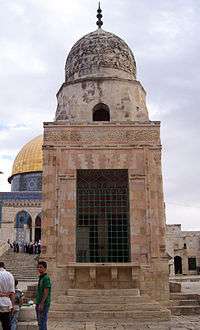Islamization of the Temple Mount
The Islamization of the Temple Mount ia a term used to describe the view that Muslim authorities have sought to appropriate and Islamicize the Temple Mount for exclusive Muslim use.[1] Originally an Israelite and subsequently Jewish holy site, as the location of the First and Second Temples, the site was subsequently the location of a Roman pagan temple,[2] a Byzantine church,[3] a garbage dump,[4] and later the Al-Aqsa Mosque. It is the holiest site in Judaism and the third holiest site in Sunni Islam.
Muslim conquest
_-_Gerusalemme.jpg)

At the time of the Muslim conquest, the Temple Mount is understood to have been the site of an elaborate Byzantine church with an elaborate mosaic floor, some of the remains of which were discovered in the 1930s by the British Mandate Antiquities Department.[3] In 682 CE, 50 years after Muhammad’s death, ‘Abd Allah ibn al-Zubayr rebelled against the Caliph of Damascus, conquered Mecca and stopped pilgrims from coming south to the Hajj in Mecca. ‘Abd al-Malik, the Umayyad Caliph, responded by creating a new holy site. He chose sura 17, verse 1, “Glory to Him who caused His servant to travel by night from the Sacred Mosque to the Farthest Mosque, whose precincts We have blessed, in order to show him some of Our Signs, He is indeed the All-Hearing, the All-Seeing.” And designated the Temple Mount in Jerusalem as the "Farthest Mosque" mentioned in that verse.
According to those who hold this view, the Islamization of the Temple Mount climaxed at the end of the seventh century, with the construction of the Dome of the Rock in the early 690s when Abd al-Malik was developing his program of Islamization. It was built over the Foundation Stone, the site of the historic Jewish Temple.[5] The al-Aqsa mosque was built at the southern end of the mount in the 8th-century. Throughout the entire period of the Muslim conquest until the capture of Jerusalem in 1099, various structures were built on the mount including memorial sites and gates.[6] From the 13th-century onwards, after the Muslims had regained control of the city, building projects in Jerusalem and around the Temple Mount sought to further establish the city’s Islamic character.[7]
In the early 19th-century, the Ottoman authorities began to permit non-Muslims to visit the Temple Mount, a policy that continued under the British Mandate but ended with the Jordanian conquest.
Post-1967

In 1990, the waqf began construction of a series of outdoor minbar (pulpits) to create open-air prayer areas for use on popular holy days.[8] A monument to the victims of the Sabra and Shatila massacre was also erected.[8] In 1996, the Waqf began underground construction of the new el-Marwani Mosque in the southeastern corner of the Temple Mount. The area was claimed by the wakf as a space that served in earlier Islamic periods as a place of prayer, but some saw the move as a part of a "political agenda"[9] and a "pretext" for the Islamization of the underground space, and believed it had been instigated to prevent the site being used a synagogue for Jewish prayers.[8][10]
See also
- Islamic structures on the Temple Mount
- Islamization of Jerusalem
- Islamization of Jerusalem under Jordanian occupation
- Islamization of Palestine
- Judaization of Jerusalem
- Religious significance of Jerusalem
- Temple Mount Sifting Project
References
- ↑ Raphael Israeli (2003). War, peace and terror in the Middle East. Psychology Press. pp. 21–. ISBN 978-0-7146-5531-4. Retrieved 3 October 2010.
During the process of the Islamization of Jerusalem, a mosque was built on the site... The Islamicized Mount became the destination of Muhammad's isra’...
- ↑ Encyclopædia Britannica 11th Edition
- 1 2 Etgar Lefkowitz (November 16, 2008). "Was the Aksa Mosque built over the remains of a Byzantine church?". Jerusalem Post. The Jerusalem Post. Retrieved May 21, 2013.
- ↑ Karmi, Ghada (1997). Jerusalem Today: What Future for the Peace Process?. Garnet & Ithaca Press. p. 116. ISBN 0-86372-226-1.
- ↑ Matthew Gordon (2005). The rise of Islam. Greenwood Publishing Group. p. 44. ISBN 978-0-313-32522-9. Retrieved 3 October 2010.
- ↑ Mahdī ʻAbd al-Hādī; PASSIA. (2007). Documents on Jerusalem. PASSIA, Palestinian Academic Society for the Study of International Affairs. p. 247. ISBN 978-9950-305-19-9. Retrieved 3 October 2010.
The Islamization of the Temple Mount culminated at the end of the seventh century, with the establishment of the Dome of the Rock above the Foundation Stone and the construction of the al-Aqsa mosque in the south of the Temple Mount.
- ↑ Hava Lazarus-Yafeh (1 December 1981). Some religious aspects of Islam: a collection of articles. Brill Archive. p. 69. ISBN 978-90-04-06329-7. Retrieved 3 October 2010.
In the same way, when Jerusalem was taken back under the leadership of Saladin in 1187, and particularly from the 13th-century and on, a great deal of building activity began around the Temple Mount and in the whole city — obviously so as to establish its Islamic character.
- 1 2 3 Contested holiness: Jewish, Muslim, and Christian perspectives on the Temple Mount in Jerusalem, Rivka Gonen, KTAV Publishing House, Inc., 2003, p.. 167-8.
- ↑ "Remnants of the Temple?," Danny Rubinstein, September 12, 2004.
- ↑ Hershel Shanks (14 October 2007). Jerusalem's Temple Mount: from Solomon to the golden Dome. Continuum. p. 76. Retrieved 3 October 2010.
In recent years Solomon's Stables have been in the news. The story is part of the larger story of the recent Islamization of the Temple Mount.